FutureTech is a premier business and technology conference, bringing together representatives from the Ross School of Business, the College of Engineering, the School of Information, and major corporations from around the world. It is one of the largest conferences at the business school and provides a forum for top talent and industry leaders to discuss the intersection of business and technology. The topic of this year’s conference is: “Innovations Worth Sharing.”
One man I believe has innovations worth sharing is Jon Goff, which is why I'm glad SEDS@UM is able to bring him to the University. Goff was one of the founding members of Masten Space Systems, winner of NASA’s Lunar Lander Challenge and Masten’s lead propulsion engineer. Now he is starting his own aerospace company, Altius Space Machines, to close many of the gaps impeding space commercialization. Goff is focusing on the rapid prototyping of new and enabling technologies for reusable launch vehicles (RLV) such as Masten’s Xogdor or Armadillo’s SuperMod. This means pursuing a wide range of product lines including nanosatellites launchers with reusable first stages, upper stages for suborbital RLVs, micro reentry vehicles, and low-maintenance thermal protection systems.
Altius Space Machines has recently signed a contract with United Launch Alliance to aid in the development of the Integrated Vehicle Fluids (IVF) system for the Centaur and Delta Second Stage. The IVF module has the potential to eliminate the need for hydrazine and helium thrusters by using the remaining LOX and LH2 in the main propellant tanks. In addition to reducing launch costs, this exciting technology is seen as a major stepping-stone towards orbital fuel depots. This announcement is following an earlier contract to develop, integrate, and flight test an avionics box and GN&C solution for a DARPA-funded project to test small-scale propulsion technologies suitable to guide the upper stage of a nanosat launcher to orbit.
Read more:
Jon Goff at Selenian Boondocks
FuturTech at U-M Ross School of Business
SEDS@UM presents "Reverend" Rick Tumlinson
0 comments Posted by helliott at Friday, December 10, 2010SEDS@UM is proud to host Rick Tumlinson for our First Annual Challenger Memorial Lecture. Tumlinson is the co-founder of the well known and influential Space Frontier Foundation, which has been called “pound for pound the most effective space organization on Earth.” A protégé of Dr. Gerard K. O’Neill, Tumlinson is a space visionary and has been named among the one hundred most influential people in the space industry by Space News. He is also known as a catalyst to the “NewSpace” revolution, leading to the  formation of private space companies by Richard Branson, Jeff Bezos and dozens of other space entrepreneurs. He led the team which leased the Russian Mir space station as the world’s first commercial space facility, signed up the first so-called “space tourist” Dennis Tito (thereby starting the commercial space travel industry), was a founding trustee of the X-Prize Foundation, Chief Executive of the $25 million FINDS space research endowment, and a co-founder of LunaCorp – which produced the first television commercial to be shot in space (for Radio Shack aboard the International Space Station).
formation of private space companies by Richard Branson, Jeff Bezos and dozens of other space entrepreneurs. He led the team which leased the Russian Mir space station as the world’s first commercial space facility, signed up the first so-called “space tourist” Dennis Tito (thereby starting the commercial space travel industry), was a founding trustee of the X-Prize Foundation, Chief Executive of the $25 million FINDS space research endowment, and a co-founder of LunaCorp – which produced the first television commercial to be shot in space (for Radio Shack aboard the International Space Station).
Over the years Tumlinson has been a lead witness in six congressional hearings on the future of NASA, the US space program and space tourism. In early 2004, he testified before Senator John McCain and the Senate Space and Technology Committee on the Moon, Mars and Beyond program. Tumlinson has given many talks and speeches in the field of space advocacy ranging from critiques and discussions of current national space policy, to the presentation of a "Frontier" ideology for opening space, to the how and why of returning to the Moon, to the search for other life and the reasons why humans are reaching for the stars. I hope to see you there!
Labels: SEDS, Space Frontier Foundation
I know some of you have been wondering what's going on in SEDS@UM these days... Other than SpaceVision and MEDMA Impulse, it seems like we haven't had a whole lot of events this year. Well, that's about to change! The council has been hard at work making travel arrangements, locking down funding, and planning logistics for three major talks in the Winter term! I wont tell you who's coming just yet, but I think it'll knock your socks off! Stay tuned to Michspace.org this week for upcoming announcements about our speakers and other great events on the schedule.
Such as: Yuri's Night 2011. That's right, we've already started planning this epic. As you know, those of us here at SEDS@UM pride ourselves on the knowledge that we not only give you access to the industry's top minds, but also the best parties. The wheels are turning and we're bringing back the folks from Necto, MEDMA, and the Russian Student Association once again to make this the biggest space rave in the Midwest. Also, I'm pleased to say for the younger crowd, we'll be having educational and outreach events throughout the week. If you would like to get involved or share your ideas, shoot an email to the council, seds-council@umich.edu. Believe me, this is going to be even bigger than before!
Space be with you,
--Harv
Labels: SEDS
Space Exploration Technologies is gearing up for the first demonstration of its Dragon space capsule aboard the Falcon 9 rocket on Tuesday, December 7. Back up flight windows are on December 8 or 9. The flight will pave the way for SpaceX to provide cargo resupply to the International Space Station. The SpaceX Student Ambassadors in conjunction with S3FL and SEDS@UM are going to have a public viewing of the launch!
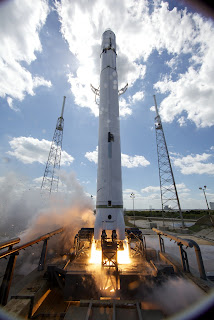
SpaceX Falcon 9 / Dragon COTS-1 Launch
Launch Window: December 7, 8, or 9 from 9 am to 12 pm
Viewing Location: EECS Atrium
Free donuts will be provided!
Sponsored by: Students Space System Fabrication Lab
& Students for the Exploration and Development of Space
Atmospheric science Ph.D. student Harvey Elliott [that's me!] spent the summer chasing dust storms and measuring their electrical charges. My travels took me to Niamey, Niger and Boulder City, Nevada where I was working with AOSS Professor Nilton Renno to better understand the phenomenon of the electrification of dust and sand particles as they bounce along a surface. I wont say too much here, but my experiences were covered recently in the November 2010 issue of Discover Magazine [page 34] and on Michigan Engineering's blog, LabLog, here.
Read more about Professor Nilton Renno
Learn more about Professor Renno's ENG 450 class
Attention: The first student built satellite from UM is launching this Friday, Nov 19. There will be a launch party in the Boeing Auditorium, FXB, starting at 8pm. Live web-coverage is available here.
Labels: Launch, Minotaur IV, RAX
Well a few days ago we got back for the SEDS Space Vision conference and I have to say it was an experience. We arrived on the second day of the conference and saw the majority of the talks. They really addressed the current state of space.
Now on to the awesome. The point of a conference is not (in my unqualified opinion) the talks, its the people you meet. Sure someone can get up and show you some pictures of what their company is doing or what they think the future will be like, but nothing compares to talking with someone one on one. Try it, look up a space mission then ask someone to tell you about their work in space and see which is more interesting. There is something engaging about the passion that can be conveyed in a conversation that is nearly imposable to convey in a presentation.
The people at Space Vision are amazing. Its a great place to meet the people who will make the future cool.
Yes, you too can kick ass in the space industry by age 30!
0 comments Posted by helliott at Saturday, November 06, 2010SpaceVision, the largest spacey student run conference in the known universe, is awesome. Unlike other gatherings of the illuminati, the young blood at SpaceVision is infinitely more approachable, more female, and yes-more female than any other conference I have attended. Granted, ISDC is amazing, but SpaceVision is AWE inspiring. No gray beards here. Only students for the exploration and development of space. Odd, seems like that's a acronym or something.
SpaceVision isn't just some technical conference, it's YOUR CONFERENCE. This is the place where you rub shoulders with the best and brightest in the industry. Because you're the best and the brightest in the industry. Okay, a little ego, but it's true. Humanity is doomed. When you see Jeff Fiege, CEO of Orbital Outfitters, up there quivering with excitement about the proprietary information he's about to reveal (no pictures please!). You know it's something special. Jeff is one of those guys who's still just a kid at heart. He's here because he's you. He's here because he was kicking ass in the space industry by age 30.
I want to kick ass in the space industry by age 30. I don't mean some high paying successful job at Lockheed, or Boeing, or Northrop Grumman, or even NASA. I mean like Peter Diamandis kick ass. I mean like George and Loretta Whitesides kick ass. I mean like Luke Skywalker kicking imperial space ass. Will Pomerantz, one of those X-Prize guys - also kicking ass, has a theory as to how you too can kick ass in the space industry by age 30. It all comes down to this, "Do something!" That's it. That's the answer! Do something! Do something you love! Do something you care about! It doesn't matter what, so long as you do something! You go Will and take your kick ass-ness with you.
So a group of us went to SpaceVision - Myself, Harvey Elliott, and Casey Keys. For those of you who don't know, SpaceVision is the annual SEDS conference. You can read about the conference by clicking here. Its a great conference for those who need a good introduction to the current happenings in space.
We got here late yesterday (11-5-2010) after driving through some snow. While we missed all of the firday sessions, we did get here in time for the after party (which, frankly, is the primary reason to go to space conferences :D ). It was good meeting up with some of the people I've met at previous conferences and events.
The sessions I saw today were
1. A Presentation on science at NASA Ames
2. A Presentation on what space will be like in 2030 (short answer - depends on who you ask)
3. A Presentation about the Orion capsule (which I did learn has a docking system that is still in flux).
4. A space policy discussion/presentation about space debris mitigation.
5. A presentation by Dr. George Nield from FAA/AST to talk about developments in Commercial Space.
Very cool stuff. Will provide more details on the way home. As will Casey & Harvey on their posts.
And we have pictures!!!
Labels: SpaceVision 2010
I built a battery charger last night using a soldering iron and $30 worth of parts from ebay. It connects four electric field sensors in series and then incorporates a balance board so that each lithium ion battery gets the same amount of juice. Pretty simply complicated if you think about it. I'm telling you this story because it looks like it came from China, and well it did - mostly, but my point is it still looks like it came from China. After all that cutting and hacking and soldering that is so often necessary for a proprietary space-y instrument, it still has that wonderful OEM finish to it. You'd never even notice it was modified and that's something I take great pride in. Making hardware for space missions that looks like you could pick it up at your local Walmart. That's an accomplishment. I wish I had my camera...
Everyone wants to be a space engineer, right? Here's a challenge, how do you boil water, in space? Too easy? How do you make a 32 turn solenoid with a radius of 30 m, in space?
So, a bunch of Michigan grads, and Michigan Students went down to watch the final launch of Atlantis.
Here are some photos, and 1 sentence reactions
Representing Michigan at Atlantis STS-132 launch. pictures to come!
-Ashwin
This trip has been awesome! 18 hr road trip, 2 minute BLOW YOUR MIND Liftoff, 1 Night camping, and soon to drive back!
- Gary
This is a story I'll tell my grandchildren... the day I saw the last shuttle launch with the Atlantis orbiter!
-Brit
Pictures and video cannot do that justice. Not even close.
-Scott
An inspiring symbol representing mankind's resistance to continuous disbelief.
-Philip
BRIGHT LIGHT!!!!!!!
-Darcy

Balloons are absolutely bursting with possibilities! The high-altitude flight that is achieved by balloons provides visibility, in situ atmospheric exploration, and access to our near space environment. High-altitude balloon design opens up new opportunities for novel technologies and applications, as well as new communication platforms. In short, balloons can be our bridge from earth to space.

The fact that we can see farm fields and the ethereal glow of the Earth’s curvature in one frame is awe-inspiring. High-altitude balloon flight allows us to reach up and experience space from our own backyards, enabling our curiosities to go to the edge of space and back.
The photos that return from these balloons are a postcard from space, saying: “Wish you were here!”
Labels: curvature, high altitude balloon, photo
University of Michigan Radio Aurora Explorer (RAX) team members Matt Bennett and Sara Spangelo both delivered highly praised presentations at the CubeSat Developers Workshop last week at Cal Poly in San Luis Obispo, California. Matt got the workshop rolling as the first speaker to present, and his discussion on the design, development, and delivery of the RAX 3U CubeSat had the whole conference buzzing about its upcoming launch.
Pictured above: Sara Spangelo presenting at Cal Poly
Sara presented her research on optimizing ground station networking and downlinking. She discussed some trailblazing concepts in supporting multiple satellites performing science missions in concert as they collect data, communicate, and downlink to Earth.
Labels: Cal Poly, CubeSat, Matt Bennett, RAX, Sara Spangelo

YURI’S NIGHT 2010: ANN ARBOR.
Much of Ann Arbor and the University of Michigan found their love for space for the first time at Ann Arbor’s first annual Yuri’s Night, a holiday celebrating human space exploration held every year in the vicinity of April 12th. Yuri’s Night celebrations have spread the world over – more than 200 parties were held this year in 67 countries – the most ever.
In Ann Arbor, Yuri’s Night 2010 was organized by the Students for the Exploration and Development of Space, the Michigan Electronic Dance Music Association, and the Russian Student Association. It was held at the Necto nightclub on Wednesday April 14th. The response from the student and Ann Arbor community was electric. More than 300 people attended, and a student society-wide costume contest attracted 10 participants. The costumes spanned from robots to nanosatellites, to Yuri himself (in the distant future), to NASA’s Area 51 DARPA Project – the ultimate victor of the contest.
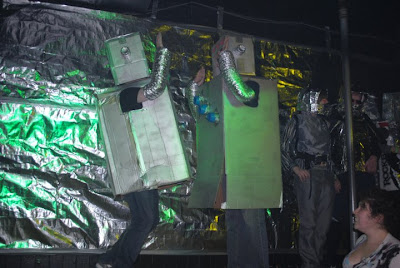
The costume contest concluded with a video greeting from one of the co-founders of Yuri’s Night, Loretta Whitesides. She told us that our impact and enthusiasm was not going unnoticed in the space community around the world. She thanked us for coming out in the name of humanity, space, and humanity in space.
The costume contest concluded with a reiteration of Loretta’s message, a transmission from myself which hopefully was received deep within the hearts of all: “You heard Loretta. Tomorrow, we go out and support the endeavors of human space exploration. Tomorrow, we change the world.” I then paused before continuing, “but TONIGHT. Tonight… we dance."
And dance we did. For Yuri, for space, for the future of humanity. Yuri, your dream lives on. We as humans will always be explorers, whether it be the depths of our hearts on the dance floor, or the silent, star-filled depths of outer space. On Yuri’s Night, we didn’t have to choose.
Michigan Nanosatellite Pipeline: Future Missions
0 comments Posted by helliott at Thursday, April 15, 2010What: AEROSP 483 - Aerospace System Design
When: Monday, April 19, 2:30-4:30p
Where: Boeing Auditorium, FXB
What: AOSS/AEROSP 583 - Space System Design
When: Monday, April 19, 5-8p
Where: Chesebrough Auditorium, Pierpont Connector
Update:
Video of the presentations is available here.
Labels: Michigan Nanosat Pipeline
I recently had the honor of judging a design contest for high school students and simply wanted to share my esteem for the two schools that participated. Both Greenhills and Macomb Center for Math and Science put together great presentations and showed some badass Solidworks skillz. Those rovers were sweet guys! I'd also like to give a big thanks to SEDS and the Michigan Mars Rover Team who brought this all together. Keep it up! I would have killed for an opportunity like this in high school.... My only hope is that next year, we can persuade even more teams to participate!
Labels: Mars
As many of you may know, the Falcon 9 launch date is closely approaching. Right now, it seems SpaceX has settled on an April 12 launch date, but this may or may not change to a later date. I bring this up to put the event into some perspective, especially in regards to Obama’s recent “change” to the space program. On a side note: maybe random acts of “change” aren’t so great after all? Did you ever think about that, Obama? Healthcare… Alright, I’ll stop there.
Back to space. What this new direction does entail is pushing space more and more into the private sector. In the short term, this could potentially mean layoffs within NASA and more budget issues, but looking ahead it gets better.
Some people are comparing this to how the computer industry shifted from being government managed to being privately managed. This, of course, spawned all sorts of goodness including the Internet, Apple, Microsoft, Google, etc. Similarly, with regards to the future of space, we’ll see reduced costs, improvements in design, and most importantly, more interest in space! With the Falcon 9 launch around the corner, we are that much closer to seeing the reality of these benefits. Plus, you’ll be that much closer to going to space. Which is what really matters.
Be sure to check out the launch.
Source: TheDailyGalaxy
So, I bet you thought there wasn't much in the way of arts & culture, as it relates to space.
Ladies & Gentlemen, I give you - Modern Space Dance
Labels: Arts and Culture
So, what did you do for your spring break? Go to Florida? Cancun? How about going to Washington DC, to lobby Congressman for Space? 
Yes, my name is Aaron Oesterle & I am a Space Geek
So, this year, for my spring break, I attended the ProSpace March Storm lobbying event. It consisted of us going to different Congressional offices, talking about the March Storm agenda. This year's agenda included:
ITAR reform
- Support the addition to the Senate version of the Foreign Relations Authorization Act the authority to remove widely available satellite systems and components from the ITAR list.
- Make certain that the bill presented to both the House and Senate for final passage retains this provision that is so vital to this nation’s international competitiveness.
- Require NASA to focus its human space flight development programs on technologies and processes designed for travel in space beyond low earth orbit.
- Support robust funding for space exploration technology demonstration projects.
- Support the transition to commercial crew and cargo services for the International Space Station.
But now I have a problem - I've been made Grassroots Organizing Coordinator. Which is why you should attend the next ProSpace Lobbying event
Labels: Politics, Spring Break
Hello,
I'd like to announce that the University of Michigan's RASC-AL team, Nergal, has been accepted into the RASC-AL competition. Team Nergal is investigating a manned mission to Mars. More information about the competition can be found here.
Nergal
Labels: RASC-AL
Lecture - "Hinode, STEREO and SOHO observations of a CME event"
0 comments Posted by helliott at Friday, March 12, 2010Enrico Landi
Astrophysicist, Naval Research Laboratory, Washington, DC
Thursday, March 18, 3:30 pm - 4:30 pm, 2246 Space Research Building
Coronal Mass Ejections (CMEs) are among the most dramatic and violent dynamic events occurring in the solar atmosphere, and have significant impact on the near-Earth environment, human activities and commercial and military communications. So far, the physical processes responsible for their release and acceleration have not been completely understood, in part because of the lack of direct measurements of the CME plasma physical parameters and evolution during the CME onset. In my talk I will describe the analysis of multiwavelength observations from Hinode, SOHO and STEREO of the very early phases of a CME observed during the Whole Heliospheric Interval campaign. I first use SECCHI/EUVI, SECCHI/COR1, SOHO/EIT and SOHO/LASCO images to reconstruct the 3D trajectory of the CME, and to measure its velocity and acceleration up to 20 solar radii. I then use Hinode/EIS and Hinode/XRT high resolution EUV spectra and X-ray images to measure the physical properties and the thermal structure of the core of the CME ejecta as a function of time at 1.1 solar radii. The physical properties of the active region location where the CME erupted are also monitored with time before, during and after the event.
Labels: space physics
I am certainly not an ace of space. I’m an aerospace engineering student at the University of Michigan. The closest I’ll ever get to space is watching 2001: A Space Odyssey and crying, alone in my mother’s basement. If I want to get closer, I might throw on a Tiesto record for good measure. I will never know more about the policies, agenda, or future of the industry than the person sitting next to me, but I will act like I do. If there’s one thing I’m good at, it’s arguing. Mostly, I argue about things that I know nothing about. The less I know, the more likely I am to anger somebody who wastes time caring about what I have to say. That’s usually my focus.
Someone told me that I should begin this blog by empathizing with my potential readers. Then I thought, people that I want reading this blog will be on the same page as me from Day 1. No introduction necessary. They’ll just “get it.” In the time you would have spent reading about my personal life, I suggest you watch this video.
That is how I feel every time the government pushes through a new “plan” that effectively reroutes the space budget. Varying government funding implies that jobs may be lost. When jobs are lost, my future looks dim, and when my future looks dim, I drink.
For all of you that are concerned about the blog title, you can rest easy. It is in fact a reference to the transcendent Swedish rock band Ace of Base. For those of you not familiar with their music, this blog is not for you.
Labels: ace of space, beer
Talk about a great idea for a cubesat! I love beer, and I love space. So how could I not love beer from space? I’m not usually one for beer gimmicks, but somehow Sapporo’s Space Barley is an exception. The beer was made with grains descended from barley that spent five months in the Zvezda Service Module on the International Space Station. The very limited results, just 250 precious six-packs, will be sold through a lottery for 10,000 yen ($110) each. But only people living in Japan are eligible. Sigh. “This beer will be sold for charity, to contribute to the promotion of science education for children and the development of space science research in Japan and Russia, through donation of all proceeds to Okayama University,” Sapporo stated in a press release Dec. 3. And that sounds nice. But I think the real reason is: Space Beer! Also, what will astronauts drink on future extended spaceflight missions? They can’t take multiple years’ worth of beer with them, so clearly they will have to brew it themselves. But what about the hops, you say? Don’t worry, those were launched into space in August. Super Space Beer! Indeed, according to Sapporo, the space-barley research was done for “the purpose of achieving self-sufficiency in food in the space environment.” Because how self-sufficient could one really be without beer? Source: www.wired.com
 Why are the Russian Academy of Sciences, Okayama University and presumably Russia’s space agency Roscosmos aiding this scheme? Well, science of course. And charity.
Why are the Russian Academy of Sciences, Okayama University and presumably Russia’s space agency Roscosmos aiding this scheme? Well, science of course. And charity.
Labels: beer, ISS, things that have flown in space
Buzz Aldrin Backs Obama in Scrapping Moon Program
0 comments Posted by helliott at Thursday, March 11, 2010On Monday, the Obama administration announced its 2010 budget for NASA. It cancels plans to return to the moon by 2020 and focuses on using commercial companies to ferry astronauts to and from orbit. While some are up in arms over the future of human spaceflight, Buzz Aldrin is backing the president in an editorial in The Huffington Post. Aldrin calls Obama's decision his "JFK moment." He praises the president for deciding "to redirect our nation's space policy away from the foolish and underfunded Moon race that has consumed NASA for more than six years, aiming instead at boosting the agency's budget by more than $1 billion more per year over the next five years, topping off at $100 billion for NASA between now and 2015." Aldrin has been far from shy about criticizing the Constellation program, previously calling the launch of its prototype rocket, Ares I-X, "fake" and "a little more than a half-a-billion dollar political show." He thinks that NASA should be spending taxpayer dollars on developing technology for trips to Mars, and he backs a "flexible path" plan that would "redirect NASA towards developing the capability of voyaging to more distant locations in space, such as rendezvous with possibly threatening asteroids, or comets, or even flying by Mars to land on its moons." NASA's administrator, Charles Bolden, said in a press conference Tuesday that he and senior White House officials will spend the next few months devising a new overarching goal for NASA, and a schedule for developing technologies to send astronauts to destinations as yet unknown. But Obama's budget proposal still has to be approved by congress. "My biggest fear is that this amounts to a slow death of our nation's human space flight program," Representative Bill Posey, Republican of Florida, said in a statement. Source: www.technologyreview.com
Labels: Buzz Aldrin, Constellation, Moon program, NASA, Politics, White House
High Altitude Solutions for a 93,000ft Problem.
0 comments Posted by asranaj at Monday, March 01, 2010Okay, so it's not as much of a problem as it is payload --one of the discoveries I made last week when Kevin Drumm allowed me to come into the the HAS workshop and poke through their stuff.
I wrote a piece a few months ago about HAS, but that was back when nothing made sense. Today, some of it made sense, proving that progress can be made even in the most confused of people.
Next week, weather permitting, of course, HAS will launch their balloon, which is made of latex by the way, and not some special space material (which I was under the impression they were made of, for some reason), ordered from a company called Kaymont. It's a "sounding" balloon, meaning that it must be. . . sound, I'm presuming. Technically, they were supposed to launch last week, but the glorious skies of Michigan prevented this from occurring.
I discovered many interesting things on my visit to what I refer to as the Balloon Room.
Discovery #1: You can track the path of the balloon online in real time during a launch! The website is aprs.fi and APRS stands for automatic position reporting system. All you have to do is type in the station name (like a radio station), which is KC9PHZ, and you can watch the balloon on its beautiful journey through the world.
#2: You launch from the Western parts of Michigan so that you can avoid situations in which your balloon lands in Lake Eerie or in the land of farmers. Essentially, you do you this to avoid having the Jet Steam push your balloon too far off course.
#3: You can kill the balloon: Attached to the payload, there is a flight termination unit that the FAA requires each balloon to be equipped with. This way, if your balloon goes berserk, you can end its life before it starts to terrorize a nearby a town or city. I imagine people don't take well to things falling from the sky these days. Especially if its as bizarre as a package of electronic do-hickeys attached to a parachute. I, for one, (if I was engineering-ly inept) would be a little concerned if such a thing fell into my yard. But hey, that is just me. And the FAA. And the rest of America.
#4: There is more. . . but I am going to draw this out for a bit and make this post a Part 1 of a two-part series. Instead, I will leave you with some pictures.
Labels: HAS
Hey
So, those of you who don't know, I also blog as Ferris Valyn, over at Dailykos. I put up a number of articles, recently, about various space issues
First flight - this was a blog entry about a trip to DC, that I and some other members of SEDS were suppose to take, but didn't. Anyway, it explains why I support President Obama's plan for NASA
Space Shuttle Replacement Pt1 - Dragon take flight - This is a blog entry about the SpaceX Dragon/Falcon 9 Spacecraft
Space Shuttle Replacement Pt2 - Birds in Space - This is a blog entry about Orbital Science's Cygnus/Taurus II Spacecraft
Space Shuttle Replacement Pt3 - Weight-loss for Spacecrafts - This is a blog entry about Boeing & ULA & Bigelow using the Atlas V vehicle, and the Orion-lite
Scientists supporting Obama's NASA - This blog entry is about Phil Platt & Derrick Pitts' supporting the President's plan for NASA
The New York Times wants a Spacefaring Future - This entry is about The New York Times support for Obama's budget
Also, as some of you know, I worked for Jim Muncy, who is a well establish space policy export. Anyway, he was on the Space Show, and talked about the President Budget - its worth a listen
Enjoy all the reading
Labels: Politics, Shuttle Replacement
 Last Friday, the University of Michigan had the privilege to host Anousheh Ansari, the first Muslim woman in space as well as entrepreneur extraordinaire. I was lucky enough to get invited to lunch with her and fifteen or so other young ambitious females. There was a sprinkling of males there as well. (I suppose that's the advantage of being so deeply involved in the space community at UM.)
Last Friday, the University of Michigan had the privilege to host Anousheh Ansari, the first Muslim woman in space as well as entrepreneur extraordinaire. I was lucky enough to get invited to lunch with her and fifteen or so other young ambitious females. There was a sprinkling of males there as well. (I suppose that's the advantage of being so deeply involved in the space community at UM.)
Ms. Ansari talked about entrepreneurship, how she got her name on the Ansari-X prize, and how she went about getting launched into space. Born in Iran, Ansari came to the US when she was sixteen years old. After getting a degree in electrical engineering, she and her husband opened a telecommunications company which they later sold. I'm not quite aware of the whole story, but it ends in success. Ms. Ansari has always had a deep interest in space her whole life and when the opportunity to get involved occurred, she took it.
The lunch was casual and very open. We asked her several questions and she was not hesitant at all to share her experiences. It was one of those things where you just sat there in awe, and simply listened, because you were too dumbfounded to contribute anything to the conversation except words that would encourage her to speak more. She was a very calm, collected, and educated woman. At the end of the day I was very honored to be able to take part in her visit to UM. Hopefully, there are more to come.
Video of her speech is available here.
Labels: people that have flown in space
Jeff Manber talking about Obama's New Space Policy
177 comments Posted by Ferris Valyn at Tuesday, February 02, 2010Labels: Politics
A Remembrance of those in the sky (Picture diary)
1 comments Posted by Ferris Valyn at Friday, January 29, 2010Today is NASA's Day of Remembrance. Its done to honor the astronauts lost during the Apollo 1 fire, the Challenger accident, and the Columbia accident
Note: - I will not be showing images of the actual accidents themselves. You can find that relatively easily on Wikipedia if you want
The Apollo 1 fire happened on January 27, 1967.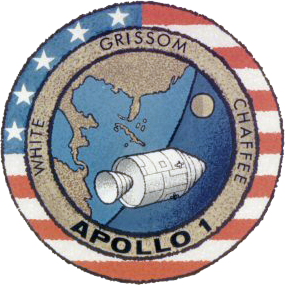
On board were Virgil I "Gus" Grissom, Edward H. White II, and Roger B. Chaffee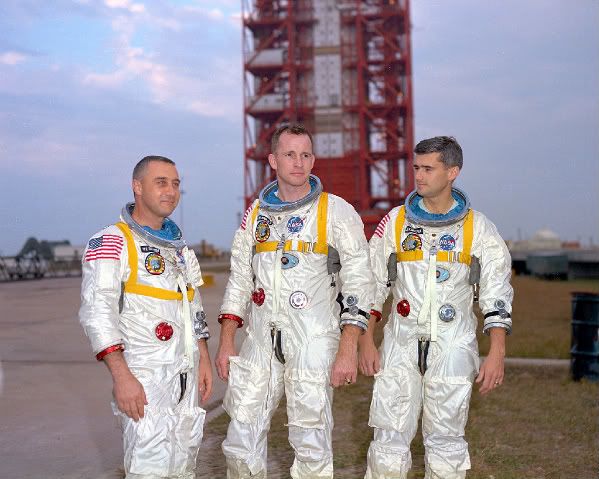
The Challenger accident happened on January 28th, 1986.
The crew consisted of Commander Francis "Dick" Scobee, Pilot Michael J Smith, Mission Specialist Ellison Onizuka, Mission Specialist Judith Resnik, Mission Specialist Ronald McNair, Payload Specialist Sharon Christa McAuliffe, and Payload Specialist Gregory Jarvis.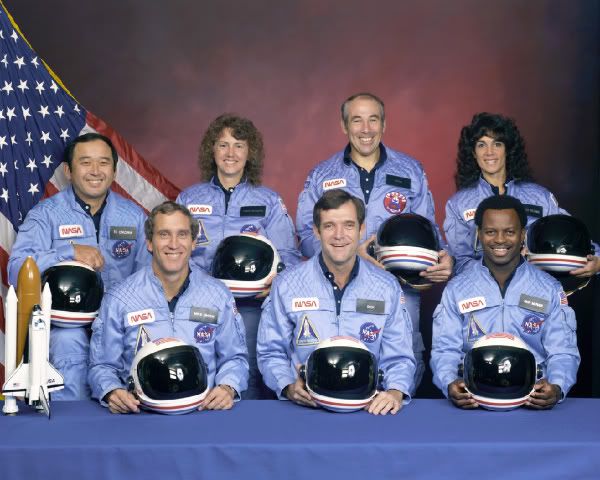
The Columbia accident happened on Feburary 1, 2003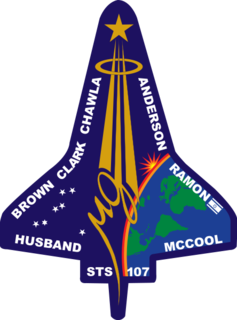
The crew consisted of Commander Rick Husband (Air Force Colonel), Pilot William McCool (Navy Commander),Payload Commander Michael Anderson (Air Force Lieutenant colonel), Payload Specialist Ilan Ramon (Israeli's first astronaut, Israeli Air Force Colonel), Mission Specialist Kalpana Chawla, Mission Specialist David Brown (Navy Captain), and Mission Specialist Laurel Clark (US Navy Captain)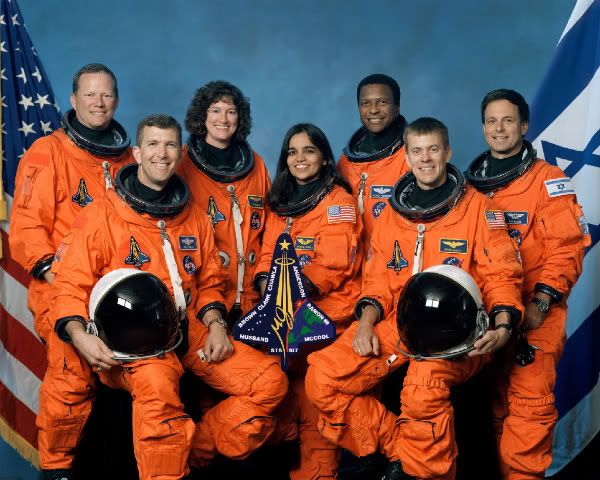
Remember them not for how they died but for those ideals for which they lived.
Ad Astra Per Aspera
Join Miles O'Brien as he talks to SpaceX founder and CEO Elon Musk
AIAA Asks Student Orgs for New Posters for FXB Atrium
0 comments Posted by greglw at Sunday, January 24, 2010On Wednesday, January 20th, the leaders of Aerospace student groups received a email densely adorned with multicolored bold text asking them to produce new posters for display in the FXB Atrium.






